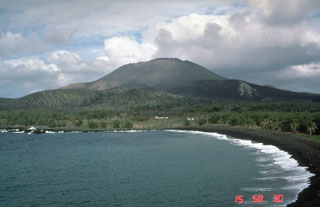Report on Pagan (United States) — May 1993
Bulletin of the Global Volcanism Network, vol. 18, no. 5 (May 1993)
Managing Editor: Edward Venzke.
Pagan (United States) Intermittent ash emissions
Please cite this report as:
Global Volcanism Program, 1993. Report on Pagan (United States) (Venzke, E., ed.). Bulletin of the Global Volcanism Network, 18:5. Smithsonian Institution. https://doi.org/10.5479/si.GVP.BGVN199305-284170
Pagan
United States
18.13°N, 145.8°E; summit elev. 570 m
All times are local (unless otherwise noted)
The emergency declaration of 15 March, putting Pagan Island off-limits to all visitors, boaters, and airmen, was extended on 2 June (until further notice) because of continued volcanic activity. Characteristic daily seismicity in May and early June indicated continued intermittent ash ejections from North Pagan, the larger of the two strato-volcanoes on the island. Eruption columns to 2 km have been reported by aircraft. Intermittent ash eruptions were accompanied by a change in seismicity in mid-February (18:3). Increased levels of banded tremor in March were thought to be associated with frequent ash emissions. Columns rising to 2 km were observed in mid-January and 17 March.
Geological Summary. Pagan Island, the largest and one of the most active of the Mariana Islands volcanoes, consists of two stratovolcanoes connected by a narrow isthmus. Both North and South Pagan stratovolcanoes were constructed within calderas, 7 and 4 km in diameter, respectively. North Pagan at the NE end of the island rises above the flat floor of the northern caldera, which may have formed less than 1,000 years ago. South Pagan is a stratovolcano with an elongated summit containing four distinct craters. Almost all of the recorded eruptions, which date back to the 17th century, have originated from North Pagan. The largest eruption during historical time took place in 1981 and prompted the evacuation of the sparsely populated island.
Information Contacts: R. Koyanagi, HVO; R. Chong, Disaster Control Office, Saipan.

